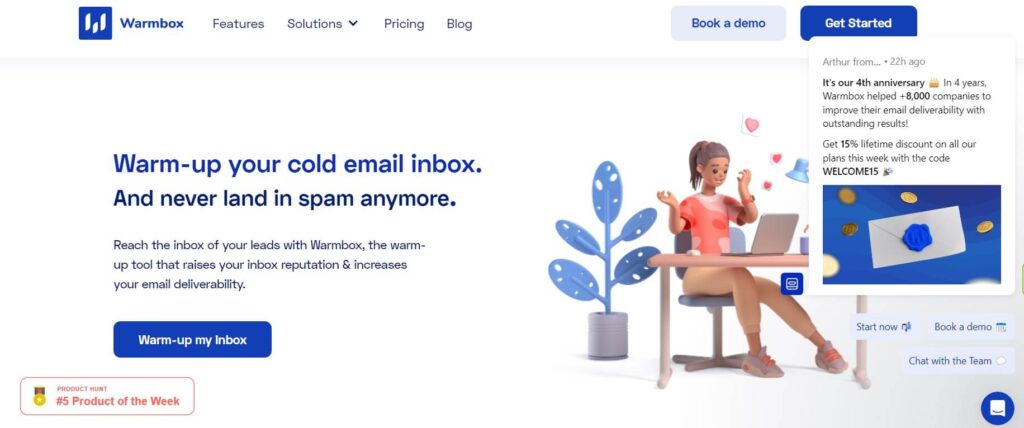The success of email marketing campaigns heavily relies on the deliverability of your emails, making email warming an indispensable step. In this guide, we compare two leading SaaS tools in the email warming space: Warmbox and Mailwarm, to help you decide which tool best suits your needs.
Warmbox

Warmbox is designed to enhance your email sender reputation, ensuring your emails reach the inbox. It supports up to 15,000 warm-up emails per month and offers features like blacklist monitoring and a variety of free tools for email health checks. Warmbox is recognized for its user-friendly interface and efficient setup process, making it a solid choice for both experienced marketers and newcomers.
Mailwarm

Mailwarm enters the scene as a competitor with a focus on simplicity and effectiveness. It matches Warmbox’s capacity with up to 15,000 warm-up emails per month and emphasizes a quick 2-minute setup process. Although it lacks free tools and blacklist monitoring, Mailwarm compensates with high user satisfaction, as evidenced by its positive reviews on G2 and Capterra.
Email Providers and SMTP Compatibility
Warmbox and Mailwarm both support a wide range of email providers, including popular services like Gmail, Outlook, and custom SMTP servers. This compatibility ensures that regardless of the email platform users are on, they can easily integrate with either Warmbox or Mailwarm to start their email warming process without hassle. This feature is especially beneficial for businesses that use multiple email providers or have a diverse email infrastructure, as it allows for a seamless transition and implementation of email warming practices across different platforms.
Warm-Up Volume
The capability to support up to 15,000 warm-up emails per month by both Warmbox and Mailwarm demonstrates their suitability for users ranging from individual entrepreneurs to large enterprises. This high volume capacity is pivotal for users aiming to scale their email marketing efforts and enhance the deliverability of a substantial number of emails. It’s an essential feature for those who are aggressively expanding their email lists or regularly engage in high-volume email campaigns, ensuring that their sender reputation remains positive and their emails consistently reach their intended recipients.
Ease of Use
The emphasis on user experience is a standout feature for both platforms. Warmbox’s user-friendly interface and straightforward setup process ensure that users can quickly integrate their email accounts and start the warming process without needing extensive technical knowledge. On the other hand, Mailwarm’s focus on a rapid, 2-minute sign-up process underscores its commitment to efficiency and simplicity, making it an attractive option for users who value quick setup without compromising on effectiveness. These aspects are crucial for ensuring that users of all technical backgrounds can effectively use these tools to improve their email deliverability.
Free Tools
Warmbox distinguishes itself with its offering of free tools that go beyond email warming, such as email health checks and monitoring tools. These additional resources provide users with valuable insights into their email performance, helping them identify and resolve potential issues before they affect their sender reputation. This proactive approach to maintaining email health is a significant advantage for users who want to take a comprehensive approach to email deliverability.
Blacklist monitoring
The inclusion of blacklist monitoring by Warmbox is another layer of protection for users’ sender reputation. By alerting users if their email addresses are at risk of being blacklisted, Warmbox helps prevent potential deliverability issues before they arise. This preemptive feature is particularly beneficial for users who rely heavily on email marketing, as it helps ensure their campaigns run smoothly without interruption due to blacklisting issues.
API Access
The absence of API access in both Warmbox and Mailwarm indicates a focus on providing a streamlined, user-friendly experience that doesn’t require technical integration via APIs. This decision reflects a prioritization of ease of use and accessibility for a broad user base, including those without programming skills or resources to develop custom integrations.
Customer Support
The commitment to comprehensive customer support by both platforms through chat and email is a testament to their dedication to user satisfaction. This support ensures that users can receive timely assistance with any issues or questions, enhancing their overall experience and success with the platform.
Free Trial and Feedback
The approach to user feedback and trial options differs between the two platforms. Mailwarm’s reliance on its strong reputation, supported by high ratings on platforms like G2 and Capterra, speaks to its effectiveness and user satisfaction. Conversely, Warmbox’s choice not to offer a free trial but instead provide a broad range of features and support options suggests confidence in the value and quality of their service, aiming to attract users based on the strength of their offerings and customer service.
Conclusion
Choosing between Warmbox and Mailwarm depends on your specific needs and preferences. Warmbox offers a broader range of features, including free tools and blacklist monitoring, making it a comprehensive solution for email warming. Mailwarm, on the other hand, focuses on simplicity and effectiveness, evidenced by its quick setup process and positive customer feedback.
For those seeking the utmost in email deliverability enhancement, consider Warmy.io. With the largest number of warm-up emails per month at 60,000, a suite of features, the most in-depth free email deliverability test, numerous free tools, and exceptional support, Warmy.io stands out as the premier choice for maximizing your email marketing campaign’s success.











